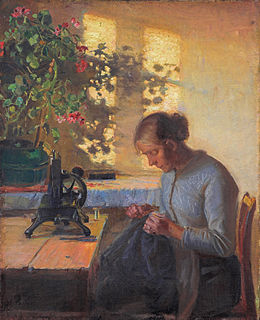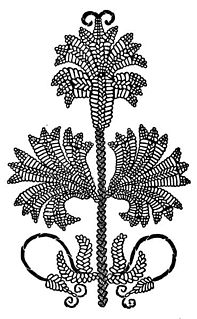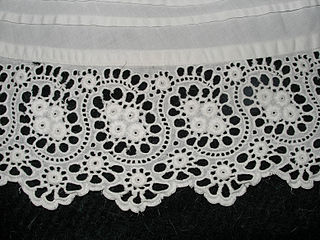
Cross-stitch is a form of sewing and a popular form of counted-thread embroidery in which X-shaped stitches in a tiled, raster-like pattern are used to form a picture. The stitcher counts the threads on a piece of evenweave fabric in each direction so that the stitches are of uniform size and appearance. This form of cross-stitch is also called counted cross-stitch in order to distinguish it from other forms of cross-stitch. Sometimes cross-stitch is done on designs printed on the fabric ; the stitcher simply stitches over the printed pattern. Cross-stitch is often executed on easily countable fabric called aida cloth whose weave creates a plainly visible grid of squares with holes for the needle at each corner.

Embroidery is the craft of decorating fabric or other materials using a needle to apply thread or yarn.

A needlework sampler is a piece of embroidery or cross-stitching produced as a 'specimen of achievement', demonstration or a test of skill in needlework. It often includes the alphabet, figures, motifs, decorative borders and sometimes the name of the person who embroidered it and the date. The word sampler is derived from the Latin exemplum, which means 'example'.

Hardanger embroidery or "Hardangersøm" is a form of embroidery traditionally worked with white thread on white even-weave linen or cloth, using counted thread and drawn thread work techniques. It is sometimes called whitework embroidery.
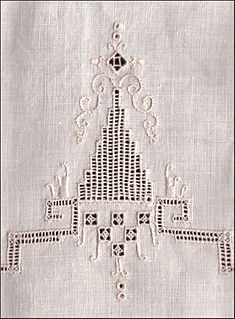
Drawn thread work is a form of counted-thread embroidery based on removing threads from the warp and/or the weft of a piece of even-weave fabric. The remaining threads are grouped or bundled together into a variety of patterns. The more elaborate styles of drawn thread work use a variety of other stitches and techniques, but the drawn thread parts are their most distinctive element. It is also grouped as whitework embroidery because it was traditionally done in white thread on white fabric and is often combined with other whitework techniques.

Berlin wool work is a style of embroidery similar to today's needlepoint. It was typically executed with wool yarn on canvas. It is usually worked in a single stitch, such as cross stitch or tent stitch although Beeton's book of Needlework (1870) describes 15 different stitches for use in Berlin work. It was traditionally stitched in many colours and hues, producing intricate three-dimensional looks by careful shading. The design of such embroidery was made possible by the great progresses made in dyeing in the 1830s, especially by the discovery of aniline dyes which produced bright colors.
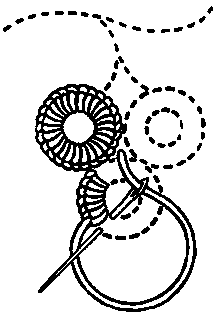
In everyday language, a stitch in the context of embroidery or hand-sewing is defined as the movement of the embroidery needle from the back of the fibre to the front side and back to the back side. The thread stroke on the front side produced by this is also called stitch. In the context of embroidery, an embroidery stitch means one or more stitches that are always executed in the same way, forming a figure. Embroidery stitches are also called stitches for short.

Darning is a sewing technique for repairing holes or worn areas in fabric or knitting using needle and thread alone. It is often done by hand, but it is also possible to darn with a sewing machine. Hand darning employs the darning stitch, a simple running stitch in which the thread is "woven" in rows along the grain of the fabric, with the stitcher reversing direction at the end of each row, and then filling in the framework thus created, as if weaving. Darning is a traditional method for repairing fabric damage or holes that do not run along a seam, and where patching is impractical or would create discomfort for the wearer, such as on the heel of a sock.
Filet lace is the general word used for all the different techniques of Embroidery on Knotted Net. It is a hand made needlework created by weaving or embroidery using a long blunt needle and a thread on a ground of knotted net lace or Filet Work made of square or diagonal meshes of the same sizes or of different sizes. Lacis uses the same technique but is made on a ground of Leno or small canvas.

Backstitch or back stitch and its variants stem stitch, outline stitch and split stitch are a class of embroidery and sewing stitches in which individual stitches are made backward to the general direction of sewing. In embroidery, these stitches form lines and are most often used to outline shapes and to add fine detail to an embroidered picture. It is also used to embroider lettering. In hand sewing, it is a utility stitch which strongly and permanently attaches two pieces of fabric.
Surface embroidery is any form of embroidery in which the pattern is worked by the use of decorative stitches and laid threads on top of the foundation fabric or canvas rather than through the fabric; it is contrasted with canvas work.
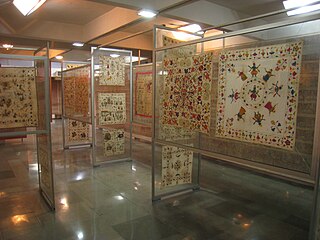
Embroidery in India includes dozens of embroidery styles that vary by region and clothing styles. Designs in Indian embroidery are formed on the basis of the texture and the design of the fabric and the stitch. The dot and the alternate dot, the circle, the square, the triangle, and permutations and combinations of these constitute the design.

The running stitch or straight stitch is the basic stitch in hand-sewing and embroidery, on which all other forms of sewing are based. The stitch is worked by passing the needle in and out of the fabric. The needle is always pushed through both layers of cloth starting on the side it is on and ending on the other side. A running stitch runs through the fabric. Running stitches are most often not visible as they are used to close seams.

Suzani is a type of embroidered and decorative tribal textile made in Tajikistan, Uzbekistan, Kazakhstan and other Central Asian countries. Suzani is from the Persian سوزن Suzan which means needle. The art of making such textiles in Iran is called سوزندوزی Suzandozi (needlework).

English embroidery includes embroidery worked in England or by English people abroad from Anglo-Saxon times to the present day. The oldest surviving English embroideries include items from the early 10th century preserved in Durham Cathedral and the 11th century Bayeux Tapestry, if it was worked in England. The professional workshops of Medieval England created rich embroidery in metal thread and silk for ecclesiastical and secular uses. This style was called Opus Anglicanum or "English work", and was famous throughout Europe.
Sewing is the craft of fastening or attaching objects using stitches made with needle and thread. Sewing is one of the oldest of the textile arts, arising the in Paleolithic Era. Although usually associated with clothing and household linens, sewing is used in a variety of crafts and industries, including shoemaking, upholstery, sailmaking, bookbinding and the manufacturing of some kinds of sporting goods. Sewing is the fundamental process underlying a variety of textile arts and crafts, including embroidery, tapestry, quilting, appliqué and patchwork.



